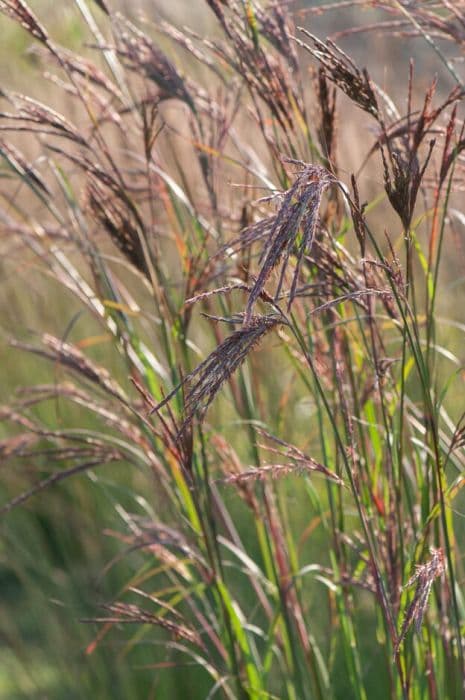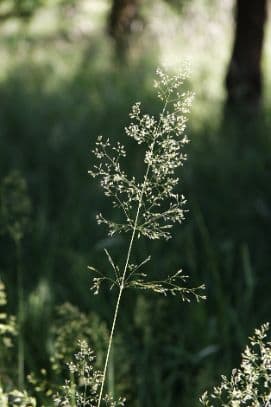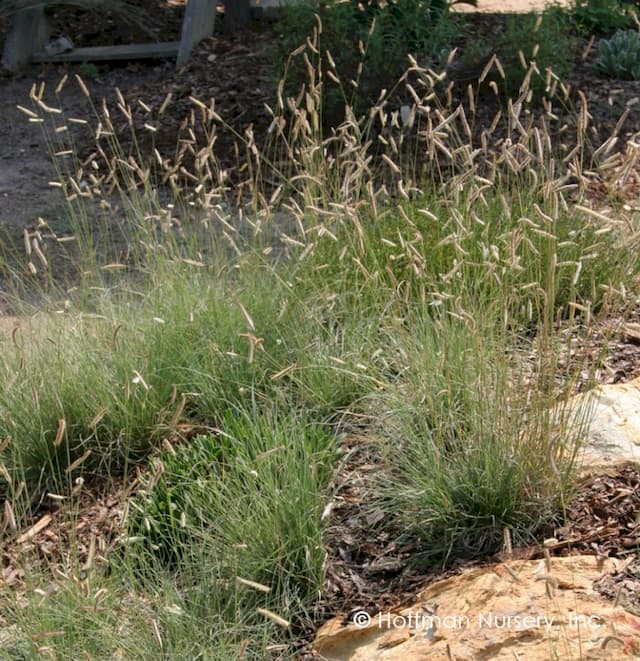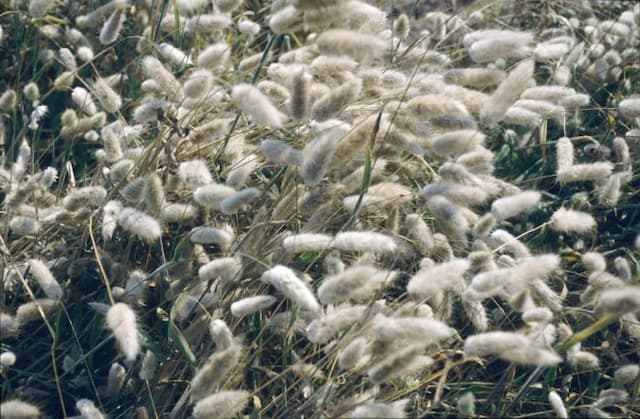Maiden grass Miscanthus sinensis 'Adagio'











ABOUT
The plant known as 'Adagio' is a cultivar of Maiden Grass, featuring fine, narrow foliage that exhibits a graceful, arching form. Its leaves are a light green color that transition into a beautiful golden hue with the arrival of fall, giving the plant a warm and inviting appearance as the seasons change. The texture of the foliage is one of the defining characteristics of this variety, adding a sense of delicacy to the plant’s overall look. During the late summer to early fall period, 'Adagio' Maiden Grass produces spectacular feathery plumes. These plumes start out with a pink tint and gradually mature into a creamy white as the season progresses. These attractive plumes rise above the foliage and add a vertical dimension to the plant's presentation, making it an eye-catching addition to any landscape. The overall shape of 'Adagio' Maiden Grass is that of a mound, with its leaves gently cascading down from the center. This mounded form is compact and dense, providing a neat appearance throughout the growing season. In winter, the golden-brown foliage and plumes can provide visual interest, even as the rest of the garden may lie dormant. This plant's ability to retain its structure in winter makes it a valuable element for year-round garden appeal. The aesthetic quality of 'Adagio' Maiden Grass makes it a popular choice for gardens where movement, texture, and seasonal color changes are desired features.
About this plant
 Names
NamesFamily
Poaceae
Synonyms
Eulalia, Maiden Grass, Zebra Grass, Chinese Silver Grass, Porcupine Grass
Common names
Miscanthus sinensis 'Adagio'.
 Toxicity
ToxicityTo humans
Maidenhair grass is not commonly known to be toxic to humans. There are no widely recognized symptoms associated with poisoning from ingesting this plant, as it is generally not considered poisonous.
To pets
Maidenhair grass is also not commonly known to be toxic to pets. It isn't typically associated with poisoning in animals, and there are no well-documented cases or symptoms that suggest it is harmful to pets if ingested.
 Characteristics
CharacteristicsLife cycle
Perennials
Foliage type
Deciduous
Color of leaves
Green
Flower color
Pink
Height
4 feet (1.2 meters)
Spread
3 feet (0.9 meters)
Plant type
Grass
Hardiness zones
5
Native area
Asia
Benefits
 General Benefits
General Benefits- Ornamental Value: Adds visual appeal to gardens with its fine-textured silver-green foliage and graceful form.
- Drought Tolerance: Once established, it can withstand periods of low water availability, making it suitable for xeriscaping.
- Low Maintenance: Requires minimal care once established, with little need for fertilizing or pruning.
- Cold Hardy: Can thrive in a variety of climates, including areas with cold winters.
- Erosion Control: Its dense root system helps to stabilize soil and prevent erosion on slopes or in areas prone to degradation.
- Wildlife Habitat: Provides shelter and food for birds and other wildlife.
- Seasonal Interest: Offers year-round visual interest, with foliage that changes color in autumn and flower plumes that persist into winter.
- Privacy Screen: Grows tall enough to serve as a natural screen or hedge, adding privacy to outdoor spaces.
- Adaptable: Versatile plant that can thrive in various soil types, from clay to sandy soils.
- Fast Growth: Rapid growth rate allows for quick establishment and filling in of garden areas.
 Medical Properties
Medical PropertiesThis plant is not used for medical purposes.
 Air-purifying Qualities
Air-purifying QualitiesThis plant is not specifically known for air purifying qualities.
 Other Uses
Other Uses- Miscanthus 'Adagio' can be used for paper-making because its high cellulose content makes it suitable for creating a strong and durable paper.
- This ornamental grass can serve as a natural musical instrument, as its dry canes can be crafted into whistles or simple flutes.
- The plant's sturdy stems can be used in lightweight construction or crafts, such as making frames for lanterns or kites.
- Miscanthus 'Adagio' can be incorporated into fashion design, with its elegant leaves and plumes used as decorative elements in hats and other accessories.
- The tall, dry stalks are ideal for creating privacy screens or garden borders when planted closely together.
- Its dried plumes can be used as a natural stuffing material for pillows, providing a rustic aesthetic and texture.
- Miscanthus 'Adagio' can be used in basket-weaving projects, offering a unique, fibrous material that can add a natural look to handcrafted baskets.
- The grass can be utilized in soundproofing applications for its ability to absorb and block sound waves in indoor spaces.
- Culms of Miscanthus 'Adagio' can be used to make bio-based composites, an eco-friendly alternative to synthetic materials in manufacturing.
- Its dense growth habit can be harnessed to prevent soil erosion on slopes and river banks, helping to stabilize the ground and support local ecosystems.
Interesting Facts
 Feng Shui
Feng ShuiThe Maiden Grass is not used in Feng Shui practice.
 Zodiac Sign Compitability
Zodiac Sign CompitabilityThe Maiden Grass is not used in astrology practice.
 Plant Symbolism
Plant Symbolism- Adaptability: The Miscanthus sinensis 'Adagio', commonly known as Maiden Grass, is a versatile plant that can thrive in a variety of soil types and conditions, symbolizing the ability to adapt and flourish in different environments.
- Resilience: Maiden Grass is known for its hardiness and ability to withstand harsh conditions, representing resilience and the capability to persevere through challenges.
- Grace: With its fine foliage and elegant, flowing form, Maiden Grass embodies grace and delicacy, suggesting a sense of beauty and poise.
- Growth: As a fast-growing ornamental grass, Maiden Grass signifies growth and the natural progression of life, encouraging personal development and expansion.
- Privacy: Often used as screening plants in landscapes, Maiden Grass represents the need for privacy and creating personal space for contemplation and protection.
 Water
WaterMaiden Grass requires consistent moisture and should be watered deeply once a week, allowing the soil to slightly dry between waterings. Depending on the climate and soil conditions, it may require more frequent watering, especially during peak summer heat. It's recommended to provide at least 1 to 1.5 gallons of water weekly for an established plant, increasing that during periods of drought or extreme heat.
 Light
LightMaiden Grass thrives in full sun, requiring at least 6 hours of direct sunlight daily for optimal growth and flowering. It should be planted in a spot where it can receive unfiltered sunlight throughout the day. Partial shade is acceptable but may result in less vigorous growth and fewer blooms.
 Temperature
TemperatureMaiden Grass is hardy and can tolerate a range of temperatures, broadly between 5°F and 90°F. However, it prefers a temperate climate and grows best with temperatures between 50°F and 75°F. This grass can endure occasional cold snaps, but prolonged exposure to temperatures below 5°F may damage the plant.
 Pruning
PruningMaiden Grass should be pruned back in late winter or early spring before new growth begins. Cut the entire plant back to 4 to 6 inches above the ground to encourage healthy, fresh growth. Annually pruning is sufficient, although removing dead or broken stems throughout the year as needed is also recommended.
 Cleaning
CleaningAs needed
 Soil
SoilMaiden Grass prefers well-drained soil with a pH range of 5.5 to 7.5. A mix combining garden soil, compost, and peat or sand enhances drainage.
 Repotting
RepottingMaiden Grass is typically not repotted as it's a large, perennial grass grown outdoors.
 Humidity & Misting
Humidity & MistingMaiden Grass is tolerant of a wide range of humidity conditions and thrives in average outdoor humidity.
 Suitable locations
Suitable locationsIndoor
Not ideal for indoors; Maiden Grass needs full sun and space to grow.
Outdoor
Plant in full sun, well-drained soil, space clumps 3-4 feet apart.
Hardiness zone
5-9 USDA
 Life cycle
Life cycleThe life cycle of Miscanthus sinensis 'Adagio', commonly known as Adagio Maiden Grass, begins with seed germination in the spring when temperatures warm up. It quickly establishes a root system and starts producing shoots, which develop into a dense clump of slender, arching leaves. Throughout the summer, it continues to grow vegetatively, gaining height and width while the foliage turns green to silver-green. By late summer to early fall, it produces feathery flower plumes that can exhibit shades of pink, red, or silver, adding visual interest to the landscape. Once winter arrives, the grass becomes dormant, and the foliage and flowers dry out, providing texture and interest even during the colder months. As spring approaches once again, the plant can be cut back to a few inches above the ground to make way for new growth, repeating its annual life cycle.
 Propogation
PropogationPropogation time
Spring-Early Summer
Miscanthus sinensis 'Adagio', commonly known as Adagio Maiden Grass, is typically propagated through division. This is the most popular method due to its simplicity and effectiveness. The best time to divide Adagio Maiden Grass is in the late winter to early spring before new growth begins. To propagate by division, a gardener should dig up a mature clump and carefully separate it into smaller sections ensuring that each new piece has several shoots and a portion of the root system. These divisions can then be replanted at the same depth they were originally growing, spaced about 3 to 4 feet apart to accommodate future growth. Water the new divisions thoroughly after planting to help establish them. No special treatment is necessary, and with proper watering and occasional feeding, the new plants should thrive and mature within a few growing seasons.









